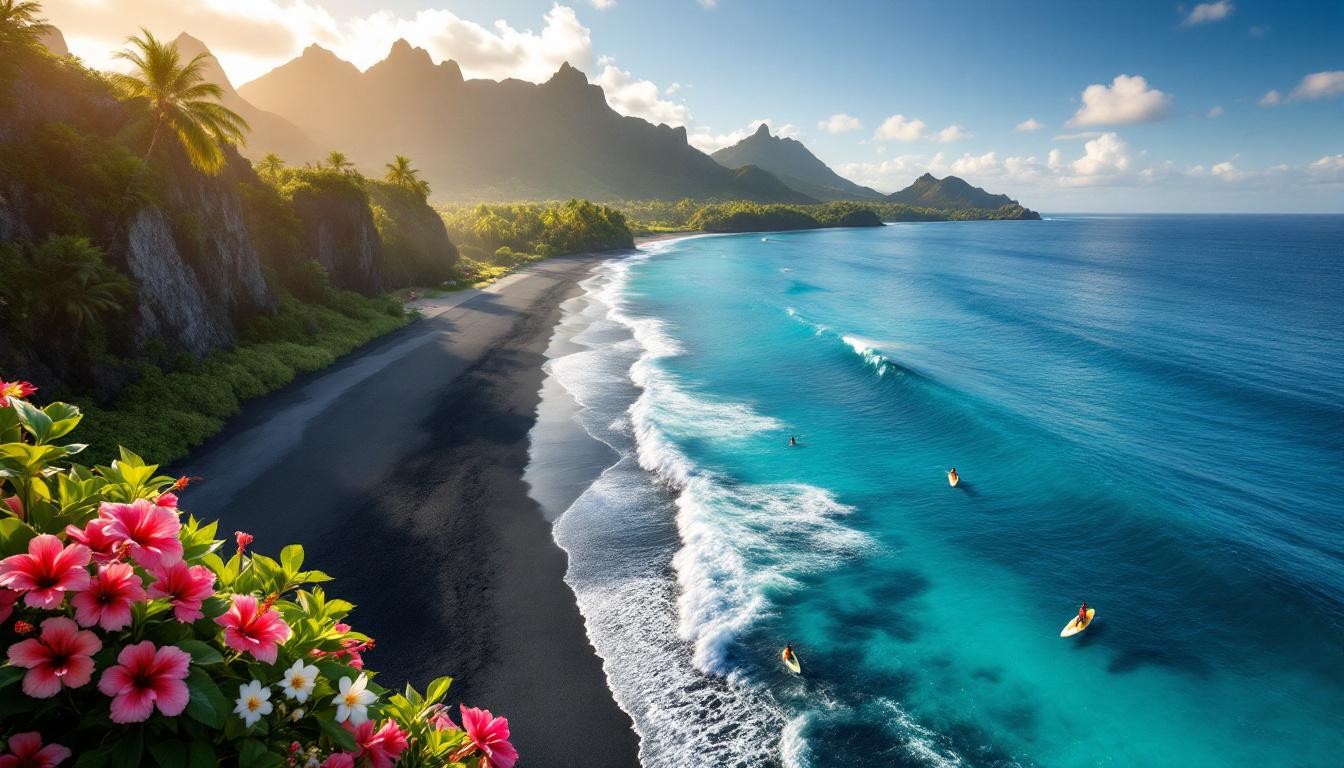The moment I first glimpsed Taharuu Beach’s obsidian shoreline stretching beneath Mount Orohena’s volcanic peaks, I understood why locals guard this treasure so fiercely. While millions chase overpriced perfection in Bora Bora’s crowded lagoons, this 300-meter strip of black sand offers everything Polynesia promises—authentic surf culture, dramatic beauty, and genuine local warmth—at a fraction of the cost.
Forget the Instagram fantasy. Taharuu delivers the real French Polynesia experience that costs 80% less than Bora Bora’s manufactured paradise, where overwater bungalows start at $1,500 per night while Paparā’s family-run pensions welcome travelers for under $200.
The numbers don’t lie: Bora Bora receives 300,000+ annual visitors cramming into limited resort spaces, while Taharuu’s volcanic coastline hosts maybe 50 surfers on busy weekends. This isn’t secrecy—it’s simply authentic Tahitian life continuing as it has for generations.
Why Bora Bora’s paradise promises fall short
The crowd reality behind luxury marketing
Bora Bora’s 12 overwater resort clusters funnel thousands of tourists through identical experiences—helicopter tours, shark feeding, and sanitized cultural shows. Every sunset photo spot draws queues of selfie-seekers, while resort beaches become extension of poolside lounging. The famous lagoon, though stunning, offers limited wave action and feels more like an expensive swimming pool than a dynamic ocean environment.
Hidden costs that destroy vacation budgets
Beyond accommodation sticker shock, Bora Bora’s isolation creates captive pricing on everything. Simple meals cost $80-120 per person at resort restaurants, while grocery basics like bottled water reach $8-12. Transportation between motus requires expensive boat transfers, and activities like lagoon tours start at $200 per person for basic packages.
Taharuu’s authentic advantages that matter
Real surf culture meets accessible waves
Taharuu’s reef break generates consistent 2-6 foot waves perfect for intermediate surfers, while inside sections accommodate beginners learning on forgiving black sand bottoms. Local surf schools charge $60 for full-day instruction versus Bora Bora’s limited lagoon paddleboarding at $150 per hour. The volcanic sand retains warmth, making dawn sessions comfortable in 75°F water temperatures.
Genuine cultural immersion opportunities
Paparā commune’s 3,000 residents maintain traditional Polynesian rhythms—morning fishing expeditions, afternoon breadfruit harvesting, and evening storytelling sessions under coconut palms. August coincides with Heiva festival preparations, when families practice ancient dances and crafts in their gardens rather than staged resort performances. Unlike Europe’s crowded coastal gems, this feels unforced and welcoming.
The practical benefits that transform travel experiences
Transportation freedom and exploration
Rental cars cost $35-50 daily on Tahiti, opening access to waterfalls, sacred marae sites, and fishing villages impossible to reach from Bora Bora’s isolated motus. The island’s 118-kilometer coastal road connects authentic experiences—from Papeete’s morning markets to Teahupo’o’s legendary surf breaks—creating adventures beyond beach lounging.
Accommodation options that support communities
Family pensions in Paparā offer private bungalows with kitchenettes for $120-180 nightly, including traditional breakfast featuring fresh coconut bread and local fruit. Owners share island knowledge, arrange fishing expeditions, and provide cultural context that transforms visits into meaningful exchanges rather than transactional tourism experiences.
The authentic experience mass tourism cannot replicate
Volcanic landscape drama
Taharuu’s black sand creates otherworldly beauty impossible in Bora Bora’s coral atolls. Basalt cliffs drop directly into azure waters, while native hibiscus and frangipani frame the shoreline naturally. The contrast between dark volcanic sand and turquoise waves creates photography opportunities that feel dramatic rather than merely pretty.
Local rhythm and seasonal celebrations
August marks traditional fishing season preparations, when families gather ingredients for umu earth oven feasts and practice ancestral navigation techniques. While Caribbean islands battle hurricanes, Tahiti enjoys perfect dry season conditions with consistent trade winds and minimal rainfall.
Real paradise doesn’t require $3,000 nightly accommodation or helicopter transfers to feel exclusive. Taharuu Beach proves that authentic French Polynesia thrives where volcanic sand meets traditional culture, offering experiences Bora Bora’s manufactured luxury simply cannot match. Pacific island-hopping reveals Polynesia’s diverse surf cultures, but Tahiti’s accessible authenticity makes the perfect starting point.
Essential planning details for Taharuu Beach
When should I visit Taharuu for optimal conditions?
April through October offers ideal weather with minimal rainfall and consistent surf. August provides perfect timing for Heiva cultural festival participation and 75-82°F temperatures with reliable trade winds.
How do I reach Taharuu from Papeete airport?
Rent a car at Faa’a International Airport for the scenic 45-minute drive along Tahiti’s west coast. Public buses run infrequently, making rental cars essential for beach access and island exploration freedom.
What makes Taharuu different from other Tahitian beaches?
The unique combination of black volcanic sand, consistent surf breaks, and authentic local community creates experiences unavailable at resort-dominated beaches. Traditional fishing culture remains active and welcoming to respectful visitors.
Are there accommodation options near Taharuu Beach?
Family-run pensions in Paparā commune offer authentic stays from $120-200 nightly, including traditional breakfasts and cultural insights. Book directly with families for genuine experiences and community support.
